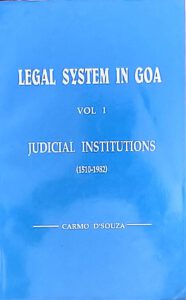
Legal System in Goa, Vol. 1, Judicial Institutions (1510-1982), by Carmo Souza, [Self-published, 1995] pp. 189; Rs 150
Carmo Souza’s book on the legal system in Goa is a welcome addition to the literature on a subject hitherto found only in Portuguese. Originally his doctoral thesis submitted to the University of Poona, it traces the developmental history of the judicial system in Goa from 1510 to 1982. This had been singled out for praise by the then chief justice of India, Mr Y. B. Chandrachud, when he inaugurated the Goa bench of the Bombay High Court at Panjim, in 1982.
Logically, the present work should have been preceded by a study on the legislation and legislative institutions of the corresponding period, in an independent volume. This is now expected to be out shortly.
The present volume assumes importance for several reasons. The Portuguese were the first colonial power to set foot and control a vast Oriental empire. Once Goa became their headquarters, the Tribunal da Relação, or High Court, was established in the old city of Goa in 1544. It administered justice at the appeal level to all the Portuguese settlements from the Cape of Good Hope to the China seas. With them was formed the modern concept of international law in trade, commerce, and navigation.
In the introductory chapter, the author refers to old and modern judicial institutions in Portugal and compares them with those set up in the Estado da Índia. Chapter 2 gives a brief idea of the pre-Portuguese judicial system in Goa, including the Comunidades, and goes on to discuss twenty major offices and institutions that administered justice sectionally, that is, “taking into consideration the different interests and pressures rising in the cosmopolitan society created by a maritime empire.” That list includes, among others, the Tribunal da Relação (treated in detail in chapter 3) and the Holy Tribunal of the Inquisition which, says the author, quoting a contemporary (ex-) Jesuit historian, had “apparently won the confidence of the natives.”
Chapter 4 dwells on the tumultuous period from 1800 to 1961, which saw the advent of constitutionalism in Portugal. A new process began with the decrees of 1832/36. Goan territory expanded with the addition of the New Conquests, where the indigenous system of judicial administration was allowed to continue, and uniform dispensation of justice came only towards the end of the nineteenth century.
“Post-Liberation Judiciary” makes up the final chapter. It treats the dismantling of a “vibrant system”. Problems encountered in the transition phase are brought out.
(‘Panorama’, The Navhind Times, 1 Oct 1995. For longer version of the review, see ‘Long Arm of the Law’, in Herald – The Illustrated Review, 15-30 June 1995)